 The photo AS15_82-11120 shows the astronaut behind the rover (doing what on it?).  In the visor of the astronaut, we see the reflection of the two antennas; but, if the reflection of the high gain antenna looks normal (the right one, circled in green), such is not the case for the low gain antenna (the left one, circled in red) of which the location on the visor is impossible, given its position relatively to the astronaut. |
 On the photo AS15-82-11155, the footprint we see looks very strange; it is not at all shaped like a normal footprint; its proportions are obviously incorrect. |
 On the photo AS15-85-11419, the shadow (circled in red) cast by the sample bag (circled in orange) is too thin in reason of its orientation; it could only be that thin if the astronaut was holding it parallel to the direction of the shadow, which is obviously not the case; you can also see that the sample bag is in oblique, and its shadow should thence normally touch the astronaut's shadow.  On the same photo, the stick the astronaut is holding seems to cast a shadow (circled in red) on his right boot; the problem is that the end of the stick (circled in orange) is too high to cast this shadow! |
 This is the way the astronaut appears seated on the rover on the photo AS15-85-11470. What is striking on this photo is that the backpack of the astronaut appears abnormally small.  If we compare with the backpack of other photos, the backpack on these ones reaches the top of the astronaut's helmet. The backpack also appears globally smaller on AS15-85-11470; in fact it appears the same size as the fake backpacks they had for public demonstrations on earth, in which they were using backpacks smaller than the real ones, and which had no function of course. |
 The photo AS15-85-11514 shows a view of the astronaut in profile.  The first observation is that, whereas the astronaut holds the double core in horizontal position, the shadow shows the same double core in vertical position.  The second observation is that, on the reflection of the astronaut's shadow in the visor, there is an element of shadow I have circled in red on the shadow which is missing! |
 The photo AS15-86-11560 shows the tripod (or gnomon, whatever you call it) and the double core behind. The tripod is on the path of the double core's shadow.  Normally, as the shadow of the tripod is practically confused with the double core's shadow at its start, if there is something in the relief which deviates the shadows, they should be deviated the same way; so, why do they diverge so consistently? |
 On the photo AS15-86-11588, we see the magnetometer, with its three branches, and the shadows of its branches. But, if two branches have normal shadows, such is not the case of the third one (the farthest from the photographer) which is oriented in such a way that it could not produce the shadow we see.  On this photo, I have corrected the shadow of the third branch to give it a more probable direction. |
 This is the magnetometer we see on the photo AS15-86-11589.  On this photo, there is a strange object I have circled which does not belong to the magnetometer, and cannot be a shadow produced by an element of the magnetometer; it is strangely shaped like an arrow. |
 The photo AS15-86-11592 shows the ALSEP in the foreground, and the rover farther in the background, that we can see on the top right of the photo. When the rover is taken close, the front wheels may seem bigger than the rear wheels (if the rover is taken in front), but, when the rover is taken from a distance, the distance which separates the wheels becomes small relatively to the distance which separates the rover from the photographer, and, in that case, the difference of size between the front wheels and the rear wheels becomes also small.  But, when we take a close-up at the rover, the front wheel appears consistently bigger than the rear wheel, like the rover was taken close! The rover has probably been first taken close, and then pasted in reduced size on the top right of the photo. |
 The photos AS15-86-11598 and AS15-86-11599 show the rover and the astronaut "busy" near it.  When we look closer, we see something interesting about the cable of the high gain antenna. You don't see what it is? 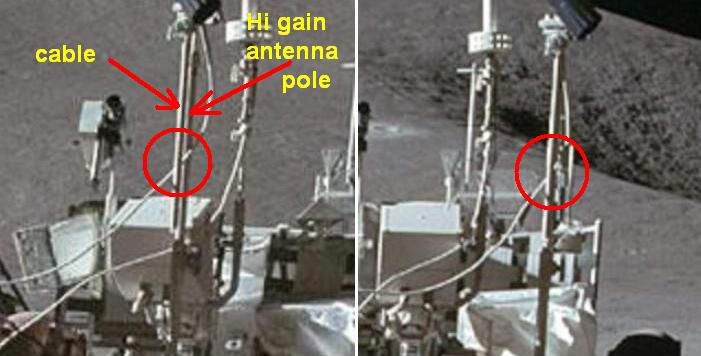 On the first photo the cable passes before the pole of the high gain antenna, whereas, on the second photo, the same cable passes behind this pole. Note: on the first photo, the pole of the high gain antenna is the right cylindric shape; the left cylindric shape that the cable passes behind is a cable (which can also be seen on the second photo). |
 The photo AS15-86-11601 shows the astronaut behind the rover. 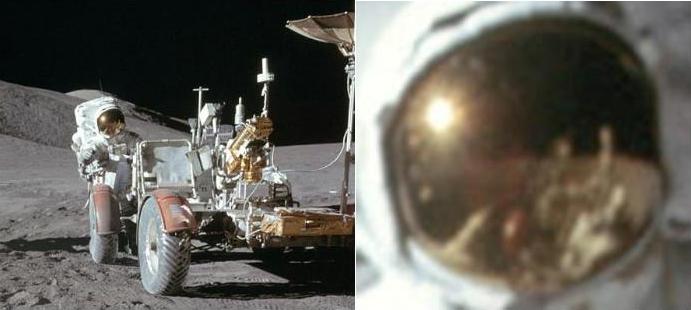 If we make a close-up on the visor of the astronaut, we can see the reflection of the low gain antenna, but the reflection of the high gain antenna...is absent! |
 On the photo AS15-86-11673, we see the tripod with its shadow.  When we take a close-up at the shadow of the tripod, we can see that there is a little stone which hides a part of the shadow produced by the multi-colored strip of the tripod. If this shadow was a black paint on the ground, it would be normal that this stone would hide a part of it, but, as this shadow is produced by the multi-colored strip of the tripod, and that this strip is above the stone, the stone should also be partially shadowed by this strip! |
 The photo AS15-87-11766 shows the tripod near a rock.  And the next photo, AS15-87-11767, shows another view of the same tripod.  The first observation is that the shadow of the part of the leg which is before the multi-colored strip (I have framed in red) is too long relatively to the shadow of the multi-colored strip itself. The second observation is that the width of the shadow of the multi-colored strip is irregular. The third observation is that one of the shadows of the legs is singularly straight, like drawn with a rule; it is the shadow of a leg which is not visible, for it is hidden by the central column. The shadow of the central column on the rock appears distorted, which is not necessarily abnormal.  But, it is when we compare the shadows of the two photos that it becomes interesting: - The shadow of the leg which is hidden by the central column on the first photo (framed in red) is straight on the first photo, but distorted on the second one. - And the shadow of the central column (framed in orange) which appears distorted on the first photo appears almost straight on the second photo! |
 The photo AS15-87-11781 shows a view of the solar wind collector.  And the photo AS15-87-11783 shows another view of the solar wind collector.  If we compare the two views of the solar wind collector, we can make an interesting observation: On the first photo, you can see that the top of the SWC is turned clockwise relatively to its base...but, on the second photo, you can see, by the fold of the SWC, that its top is conversely turned counter-clockwise relatively to its base!  In fact, the way the solar wind collector appears on the second photo, it should appear on the first photo like I have represented it on the left of this stereoscopic view. |
 On the photo AS15-87-11841, we have a view of the lunar module with a ribbon which strangely shows several knots. 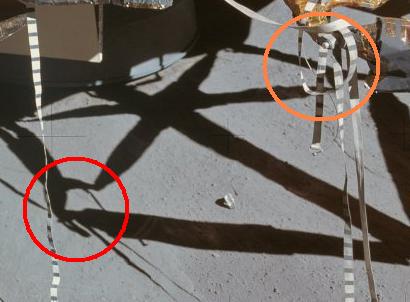 When we make a close-up on this ribbon and its shadow, we can see that the shadow of the ribbon does not show the knots we see on it! |
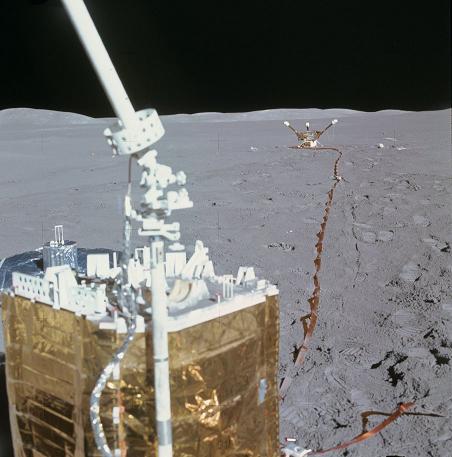 The photo AS15-87-11845 shows the ALSEP and the magnetometer farther with the connecting ribbon between them.  What is striking about this ribbon is that it is incredibly twisted a great number of times. |
 On the photo AS15-87-11852, we see the rover in the distance. As the rover is seen from quite far away, the distance between the two front wheels and the two rear wheels should show almost no difference (unlike when the rover is seen close), and the rear wheels should appear the same size as the front wheels (with quite no difference).  Yet, when we make a close-up on the rover, the right front wheel of the rover (left seen from the point of view of the photographer) appears bigger than the rear wheel which appears on its right; note that this rear wheel is the same size as the other front wheel, which shows that it is the right front wheel which is oversized; And, as the right rear wheel of the rover appears on the right of its right front wheel, the left rear wheel of the rover should also appear on the right of the left front wheel, and it does not.  I have made a correction of the rover so that the right front wheel return to its normal size, and we see appear the rear left wheel on the right of the left front wheel. |
 The photo AS15-88-11864 shows the astronaut saluting the flag with the LM in the distance. On the LM we can see the handrails that the astronaut grabs when he exits the hatch; they appear small because they are far from the photographer.  These handrails show an important difference of size; it would be normal if they were taken close, but, as they are taken from relatively far away, the distance which separates them is small relatively to the distance which separates them from the photographer; consequently they should show no consistent difference of size on the photo...and yet, they do! |
 The photo AS15-88-11894 shows a commemorative plaque put on the "lunar" ground, which bears the names of the astronaut fallen in the conquest of space. Among these names are the ones of Gus Grissom and Yuri Gagarin; both of them have found the death in dubious circumstances. In fact these astronauts are more victims of those who shamelessly exploited them than of the conquest of space.  The corners of this plaque are round, but we can see the shadow of one of them, and this shadow appears like the corner of the plaque was square instead of being round!  Before the commemorative plaque, we see a figure put on the "lunar ground".  This figure would be a statuette made by a Belgian sculptor.  The name of this sculptor would be Paul Van Hoeydonck. He would have baptized this statuette "The fallen astronaut", and given it to the NASA to be put by the astronauts on the lunar ground. But, if we compare the figure supposedly left by the astronauts on the moon with the statuette of Hoeydonck, we can start to doubt that it is really the statuette of the Belgian sculptor.  Indeed, if we look attentively, we can find several differences: 1) First, the heads look different; on the statuette of Hoeydonck, the head is regularly rounded; on the figure of Apollo, the head is first flat, and then there is a sudden angle. 2) On the statuette of Hoeydonck, the chest is perfectly smooth; on the figure of Apollo, the "chest" of the figure is not smooth, we can guess on it the extremity of the handle.  Like we can see the extremity of the handle on other hammers' heads.  3) Finally, on the statuette of Hoeydonck, the legs of the fallen astronaut are close to each other, and, on the figure of Apollo, they are more spread.  For me, it makes no doubt that what we see is in fact a hammer, of which the handle in entirely dug into the ground, and of which only the head is visible. |
 The photo AS15-88-11952 shows the shadow of the frontal parabolic antenna; but, if the photographer could see the LM's shadow from his point of view, that means that the LM is not receiving the sun frontally, but in oblique; yet the shadow of the antenna we see corresponds to the antenna receiving the sun frontally; so it is incoherent...unless the antenna has been turned (around the vertical axis)! |
 On the photo AS15-88-11975, we see the CM in the darkness of space...but the darkness is not seeming that dark, we can guess something in it.  I have added luminosity to the photo, and we see appear...what looks like a metallic ring, which might be made of copper. |
 On the photo AS15-90-12192, we see the tracks of the rover. 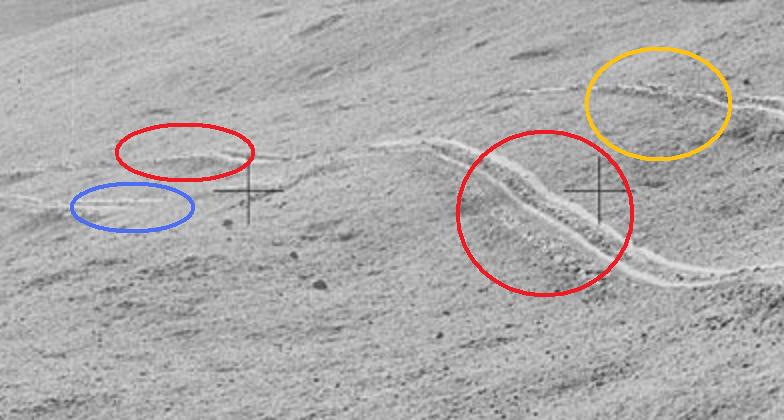 What is surprising is that there is a track (I have circled in red) which starts as the left track...and suddenly becomes the right track (for it is on the right of the other track I have circled in blue, and which is now the left track. |
 The photo AS15-90-12216 also shows tracks of the rover.  We can see that the tracks of the rover brutally change; but, what is surprising is that they change when passing over a consistent hole; why didn't the rover avoid the hole rather than making everything to pass over it, at the risk of falling into it! |
 On the photo AS15-90-12230, the hand of the astronaut is placed before the paper which hangs under the camera in such a way that the shadow of this paper should hide the shadow of the hand...but it is not the case: We see the shadow of the hand under the (too short) shadow of the paper. Note also that the camera is pointing downward on the photo...but upward on the shadow! |
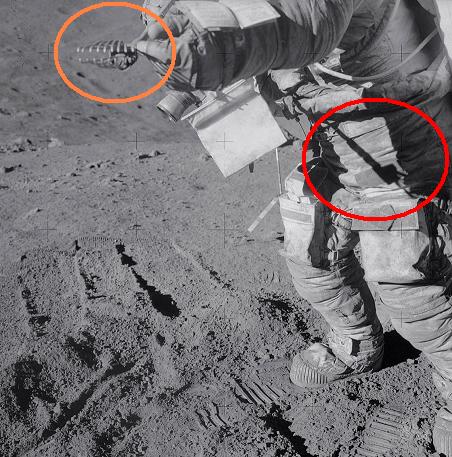 On the photo AS15-90-12233, we see the shadow (circled in red) of the brush (circled in orange); we can see that the astronaut is touching the brush with a finger; that means that the shadow of the arm is the vertical black shape we see on the right of the brush's shadow; but how could the horizontal arm of the astronaut produce a vertical shadow on his body? |
 On the photo AS15-90-12235, we can see that the astronaut has tied his watch around his forearm; but why didn't the astronaut rather tie his watch around his wrist? The way he has tied it makes it more difficult for him to read it than if he had tied it around his wrist. It seems that the astronauts were doing everything to complicate their task: Ladder too short, misplaced watch, unpractical adjustments... |
 On the photo AS15-92-12407, I have looked into the visor to see if I could find wrong reflections on it...but I have found a strange shape on it instead.  I have added luminosity on the visor, and we can see a strange thing inside, certainly not the face of the astronaut! |
 On the photo AS15-92-12412, we can see the other astronaut in the distance; this astronaut does not make me think of a real astronaut, but rather of a model.  We can see that his right arm is abnormally shadowed; yet, it can't be his left arm which shadows his right arm, for the latter is lower than the right arm, and besides we can see the shadow that it produces (circled in orange). |
 On the photo AS15-92-12416, the shadow of the other astronaut is completely inconsistent; yet the relief of the ground is relatively flat, and not so much disturbed that it could distort that much the astronaut's shadow. |
 On the photo AS15-92-12421, we can see that the "Suprathermal ion detector" (as the documentation calls it) is quite far from the ALSEP, consistently farther than the other devices attached to the ALSEP; yet this device is, like all the other devices, also attached to the ALSEP by a ribbon running on the ground; that means it would need a very long ribbon to attach it to the ALSEP; but why put it so far from the ALSEP? It is not necessary to put it so far, it obliges to have a very long ribbon, and a too long ribbon dissipates more energy than a shorter one (and stands more chance to be cut by micro-meteorites, if such meteorites really strike the moon)! |
 The photo AS15-92-12424 shows the astronaut holding the double core with the tripod on his right; his shadow also extends on his right.  If we make a close-up at the shadows and the tripod, we can see that the tripod is on the way of the double core's shadow; the shadow of the leg with the multi-colored strip is confused at its start with the shadow of the double core (at the place circled in yellow); then the shadows are deviated because of the relief...but why aren't they deviated the same? Since they are initially confused, they should be deviated the same by the relief...Yet, the shadow of the double core (circled in orange) and the shadow of the leg with the multi-colored strip (circled in red) abnormally diverge! |
 On the photo AS15-92-12434 look at the seats of the rover, and compare the top of the seat of the driver (the left one) with the top of the seat of the passenger (the right one)...it seems that the passenger of the rover is not allowed the same comfort as the driver. |
 The photos AS15-92-12444 and AS15-92-12445 show two views of the astronaut saluting the flag. Between these two views, as this animation shows, the photographer just turns his camera.  If we make a close up at the astronaut, we can see that the hand he holds in oblique appears in the visor like he was holding it straight up, vertical.  And when we look into the visor on the two photos, the photographer (the white spot I have circled) should appear the same...but he does not! |
This is what we see if I make an animation with the photos AS15-92-12450 and AS15-92-12451; the change we see comes of course from the fact that the photographer has moved (around approximately an arc of circle), but what is abnormal is that the flag should show a change of orientation on these two photos, and it does not. I have made a new animation with the orientation of the flag corrected on the second photo; of course I don't guarantee that the orientation of the flag would change this way, but, at least, here, we can see a change of the orientation of the flag when the photographer moves. |
 Like in the other missions, the lunar module has landed so to show its back to the sun, and to have its front in the shadow. On this photo, AS15-87-11796, the front of the lunar module is very visibly in the shadow, even if this photo is not very good. |
Yet...  ...If we make a close-up on the LM of the photo AS15-82-11057 (right of the stereoscopic view), the front of the LM is very visibly not in the shadow; it appears lit like it was receiving the sun frontally. |
 Moreover, on the photo AS15-87-11796 (left of the stereoscopic view), the front footpad (I have circled in red) is obviously not resting on the ground, and is at some height over the lunar ground. But, on the photo AS15-82-11057, a close-up of the lunar module (right of the stereoscopic view) shows that the same footpad is resting on the ground; or, if it is not quite touching the ground, it is is still consistently closer to it than on the photo AS15-87-11796. |
And...  ...On the photo AS15-86-11601, a close-up of the front footpad (right of the stereoscopic view) also shows the front footpad touching the ground, or at least being quite close to it, much closer than on AS15-87-11796 (left of the stereoscopic view). |
 The photos AS15-82-11200 and AS15-82-11201 show two different views of the rover which are shown on this stereoscopic view. Visibly, on the photo AS15-82-11200 (left of the stereoscopic view), the camera is oriented such that the sunlight reflecting on a metallic element on the front of the rover comes right into the lens, which explains the blur we see. On the next photo (right of the stereoscopic view), the rover is taken under a very different angle of view, so we might expect the sunlight reflected by this metallic element not to come into the lens this time...and yet it does again! |
 A photo, AS15-88-11896, shows the lunar module with a mount in the distance. |
 Another photo, AS15-88-11928, also shows the lunar module, a little closer, but the mount visible on the previous photo is no more visible; Why? |
Because... 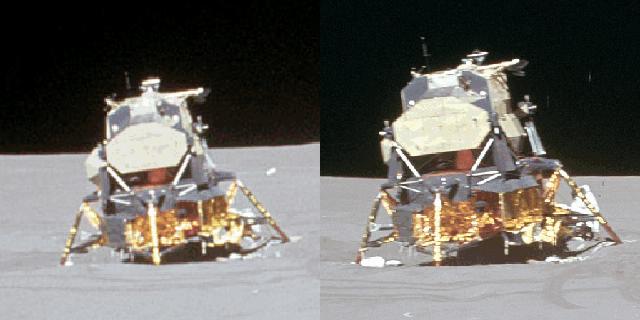 ...When we look at a close-up of the lunar module on the two photos, we can see that the lunar module of the second photo is turned counter-clockwise relatively to the lunar module of the first photo. This is because the photographer has not only moved forward, but also shifted right, which has changed the angle of view under which he sees the lunar module. |
 On the first photo, he is positioned such that he sees the lunar module frontally. |
 On the second photo, he has moved right, and consequently he sees the lunar module under a different angle. The consequence is that the background he sees is shifted left; this is why the mount he was seeing on the first photo is no more visible, it has shifted right out of the photo. |
 Now, a photo, AS15-88-11932, shows that the camera, while it can see, on the right, a part of the mount of the first photo of the LM, it can also see a smaller mount on the left; we can't see the lunar module on this photo, but it is not abnormal, because this photo is taken as the astronaut has passed the LM. |
 So, the angle of view of the camera is wide enough to see the two mounts, at least parts of them (the little mount on the left almost completely). |
 Now, on the first photo with the lunar module, the camera is oriented so that it can fully see the mount on the right, but not the smaller mount on the left. |
 And, on the second photo with the LM, the orientation of the camera has changed, and it can no more see the mount on the right; but, as its angle of view is wide enough to embrace the two mounts, it should automatically see the little mount on the left! |
 But, on the second photo with the LM, we can see that the little mount on the left is not visible; we can see a small accident in the background but it is too small, it does not correspond with the mount on the left. |
 Here is what we should see on this photo I corrected, we should see the left mount in the background of the photo, on the left of the lunar module. |
 The hypothesis that the lunar module would come exactly hide the left mount can be discarded, for this mount is wider than the lunar module, and we still could see its ends. |
 The landing site of Apollo 15 was located 26° North and only 4° East, so mostly north. |
 This means that, in order to be oriented toward the earth, which was a necessary condition to allow the transmission of the video filmed by the camera to the earth, the antenna had to be bent 26° South relatively to the local vertical. As the sun is shining from East, it means that the antenna had to be bent on the right relatively to the direction of the sun, or on the left relatively to the direction of shadows. |
 This appears to be roughly the case on the photo AS15-82-11121. |
But, on several photos (AS15-86-111471, AS15-86-11602 and AS15-86-11603), the antenna appears to be oriented vertically. Yet, meanwhile, the camera was transmitting its video without visible degradation of the quality of the image. |
 Other example of incorrectly oriented antenna: On this photo, AS15-88-11901, the antenna is obviously not turned on the left of the shadow of a quarter of turn; it is almost in the same direction as the shadow; it is very visible on the shadow of the antenna. |
 This stereoscopic view shows two different views of the moon taken from the command module, AS15-88-11985 and AS15-88-11986. On the two photos we can recognize the same artefacts. |
 In particular, there is a quite recognizable crater, of which all the details match on the two photos. I have drawn on the two photos an arrow indicating the direction of this crater on each photo, and we can see that this arrow turns a quarter of turn clockwise between the two photos. This means that: - Either the spaceship has yawed of a quarter of turn. - Or the astronaut has turned his camera a quarter of turn. The first possibility is to exclude, for the spaceship would never brutally yaw that much. The astronaut could indeed have turned his camera of a quarter of turn, but why would he have done that? When the format of the photo is rectangular, it may have an interest to turn the camera of a quarter of turn so to take the photo in portrait mode instead of landscape, but here the photo is square, so there is no interest in turning it. It can't be said it is outright impossible, but it is illogical, and why would the astronaut do something illogical? |
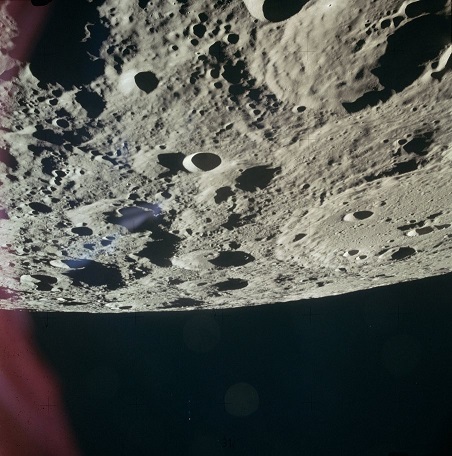 Now, if there is one of the two photos which is turned, it is certainly this one... |
 ...for if we turn it a quarter of turn clockwise, not only it is oriented like the other photo, but moreover, the moon appears in a coherent way; indeed, as the command module was orbiting the moon clockwise, the moon logically appears on the right of it. What we see on the top of the picture is obviously the upper edge of the window... |
 ...Yes, on the right side, on which we see something regular...But, on the left side, it can't be the edge of the window, it is too irregular, it is the reflection of something else; but what could it be the reflection of at this location? It does not seem as anything possible! |
 Now, if we don't turn the photo, this part could perfectly be the reflection of an arm. So, according to this reflection, the photo could not be turned, but according to both the orientation of the other photo and the logical orientation of the moon, it had to be turned. We have a logical contradiction here! |
 This stereoscopic view shows two photos of the earth rise taken from the command module (AS15-88-11988 left, and AS15-88-11999 right). It is the move of the spaceship around the moon which makes the earth rise; if the spaceship was remaining stationary relatively to the moon, the earth would remain at the same height relatively to the horizon, as the moon always shows the same face to the earth. |
 The photo of the right is taken after the photo of the left, after the spaceship has moved a little forward. Logically the earth should be higher above the horizon on the photo of the right than on the photo of the left...and yet you can see that it is the converse! |
 At the end of the mission, an astronaut takes photos of the moon as the command module is moving away from it. On this photo, AS15-88-12013, we can see the moon completely. |
 On the previous photos, the command module is closer to the moon, so we see the moon only partially. In particular, on this photo, AS15-88-12012, we can see a big part of the moon, but not as completely as on the photo AS15-88-12013. Something has struck me when I have seen this photo: The curvature of the moon on this photo is too exaggerated for a photo which only shows a part of the moon, and not in its entirety. |
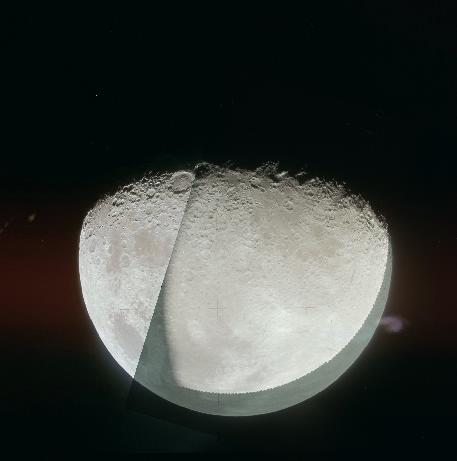 So I have superposed the two moons so to make their artifacts match (which are well visible near the shaded part). And, while the edges of the two moons should then superpose upon each other, it is clearly not the case. The one of the photo AS15-88-12012, instead of following the one of the photo AS15-88-12013, comes inside the moon of the photo AS15-88-12013, showing that this edge is abnormal. Therefore, the photo AS15-88-12012 is not a realistic photo of the moon! |